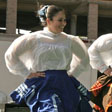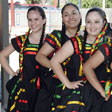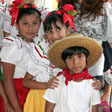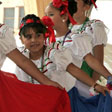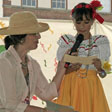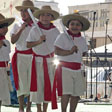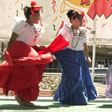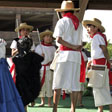Other Shreveport Articles
Cultural Preservation: Keeping the Flame Burning for Future Generations
Seasons and Cycles — Festivals and Rituals Mark Life's Rhythms
Of Hand and Heart: Handwork Connects Family and Community

Latino Cultural Rhythms in Shreveport-Bossier City: Ballet Folklorico and Salsa Dance
Bridging Cultures: Maria Austin Brings Ballet Folklorico from Mexico to Shreveport
Many of the musical and dance performers at the 2011 Cinco de Mayo Fiesta were from neighboring Texas, with several notable exceptions. Shreveport's Creswell Elementary School ESL Dancers performed ballet folklorico, a form of folk dance representing the diverse regions of Mexico. The instructor and leader for this group was Maria Austin, who began dancing ballet folklorico as a little girl in her hometown, Tuxtla Gutiérrez, capitol city of the state of Chiapas, Mexico. Growing up in Mexico, Maria learned ballet folklorico in elementary school, where traditional arts were commonly part of the curriculum.
Ballet folklorico is close to Maria's heart. As a girl, she enjoyed dancing and excelled in this art form. Growing up in Tuxtla, Maria took pride in performing at community celebrations like Cinco de Mayo, Día de las Madres (Mother's Day), Día de la Independencia, and others. Maria recalls that her dance performances were often accompanied by live music, as artists of all kinds abounded in her home region. Maria's father is a musician who played guitar and accordion during her childhood. He and his group were often called upon to play at city events. Maria remembers, "I grew up surrounded by music, different types of music. My father played all those boleros, those Trio de los Panchos, and Augustin Lara, Jorge Negrete, and Pedro Infante."
When she became an elementary school teacher in Mexico, Maria in turn taught ballet folklorico to her students at schools in various locations around the country. She explains the role of teachers in Mexico:
It's part of the tradition as a teacher. You had to teach dances, you had to be performing all the time, to entertain the community. So that's something that I really like doing. It carries on from this generation to another generation, there's just always the need or it's expected of a teacher to be presenting something for the community . . . it is our job to teach the children and prepare [them for] X performance . . . because . . . the mayor is coming, or . . . [the city is] celebrating Independence Day or Mother's Day or Teacher's Day-they're always getting the school personnel together to perform and participate in an event.
Maria was in her mid-twenties when she left Mexico to live in the United States, first in Virginia and then the Shreveport area, where she has lived since 1997. For the 2011 Cinco de Mayo Fiesta, Maria had the opportunity to rekindle her skills as a ballet folklorico teacher. That year, colleagues at Creswell Elementary School approached her about teaching the students ballet folklorico, so they could perform at the Fiesta. It was a task she happily accepted. The students enrolled in Creswell Elementary School's ESL (English as a Second Language) program are non-English speaking children from diverse countries. All of the students participating in the ballet folklorico instruction were Mexican or of Mexican descent, with roots in Veracruz, Puebla, and Central Mexico. For Maria, there are several layers of significance to the folklorico classes for the students and their families. "We always try to represent our pride as a culture, try to teach the tradition, the Mexican culture. And it teaches them so many things: cultural awareness, to value their heritage, and social skills. It exposes them to many things, many opportunities." Like Maria, the parents of her ballet folklorico students in Shreveport grew up with this tradition and were supportive of their children learning an important part of their culture.
Preparing for the Cinco de Mayo Fiesta performance took many hours of hard work, for students and teacher. Maria worked with the students after school, two to three days a week. When asked what goes into teaching ballet folklorico, Maria responds, "It's part of their history . . . [and] it's the steps, the footwork. You have to master that in order to accomplish the best performance, you have to practice so much. It's not going to happen overnight . . . it takes discipline and wanting to transform that moment into something more serious. You just cannot take it lightly."
Part of the folklorico tradition is learning and teaching dances from different regions of Mexico. In selecting a dance for the fiesta, Maria had many possibilities from which to choose. She observes, "There are so many wonderful dances, so full of emotion-well, the dances themselves are like that, very expressive. And some of them tell legends, some of them tell love stories . . . you name it." For Cinco de Mayo, the students, who ranged in age from pre-K to fifth grade, learned a dance originating in Maria's home state of Chiapas, El Jabalí [ha-la-BEE] (The Wild Boar). The story and dance originate with the Zoque, an indigenous group from the Chiapas area. The traditional dances of the Zoque are widely represented in the ballet folklorico repertoire of Chiapas.
In addition to mastering the footwork and emotional expression in the dance, students studied the legend of El Jalabí, which they explained to the audience before performing the dance. According to Maria,
A jabalí is a wild boar. There is a legend that women used to come to a nearby river to do their laundry. As they were coming down a hill, they heard a noise in the bushes and saw a big wild pig looking at them. They got scared and at first tried to kill him with stones and throwing things at him. When they saw that he did not run and was not scared, they calmed down and they decided not to make a big deal. The jabalí disappeared. This happened over and over. The women decided to play with the wild boar-chasing it, laughing, chanting. The men grew suspicious that the women were having too much fun at the river, as they were making a lot of noise and coming home late. So the men thought the women had a lover, another man. They followed the women and saw the Jabalí, [and] they decided to kill it. The women tried to stop them but the men did kill the wild boar.
Dancing in the heart of downtown Shreveport's Festival Plaza made the children feel like stars. The students' pride fuels Maria's dedication to working with the youth. She feels that dancing ballet folklorico boosts their self-esteem. She observes, "They see themselves as [having] something valuable to offer to their community. So it's important to teach them some artistic inclinations and to value where they come from. You never know how far they might go-it could open doors for the children."


